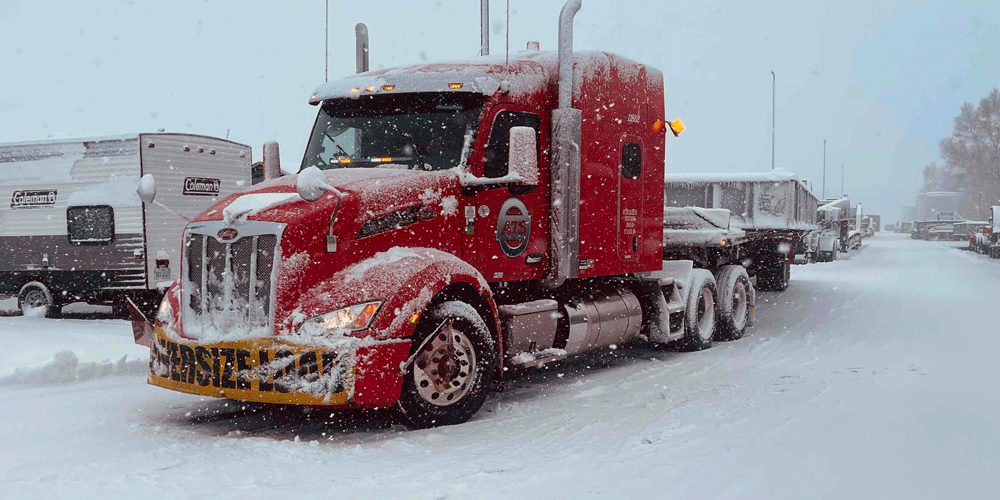Michael Carlson is a safety manager with ATS. He assists drivers, as well as the operations team, adhere to safety protocols. Before coming to ATS, he had years of hands-on safety experience. He worked for the railroad for a while before starting a career driving, where he hauled hazmat freight for eight years. Michael loves working for safety at ATS because he believes in the program. ATS has a great safety team and it takes each and every person to make the roads and the company safer.
In this down market we’re in, have you been encouraged to run more miles to earn more?
While running more miles and working harder than you have before is unfortunately what’s required to continue to make a good profit in 2024 and beyond, it doesn’t mean you need to run so many miles you’re cutting corners to do so.
Here at Anderson Trucking Service (ATS), we’re hearing about drivers rushing and practicing unsafe driving behaviors. While drivers have good intentions — making money to support their families, delivering loads on time, etc. — rushing leads to mistakes, and we all know just how costly mistakes can be in this industry.
There are other ways you can keep running a lot of miles without skipping pre-trip inspections, speeding, following too closely and otherwise cutting corners.
As safety manager at ATS, I’ll talk through the unsafe driving problems we’re seeing as a company and how drivers can improve their focus to avoid these types of accidents.
Cutting Corners to Earn More
The problem is simple: Drivers want to get more miles in to earn more money. More miles in a day equals more money, right?
That’s not totally true. In fact, the old adage runs true here: Slow and steady wins the race. Rather than looking at how many miles you run in a day, it’s better to look at how many miles you run throughout the month.
It’s not how fast you run and move in a day, but how consistent you are month over month. Being busier month over month is better than rushing through your days.
The Consequences of Cutting Corners
Rushing and cutting corners ends up leading to mistakes — as we’re seeing an influx of in recent months.
In their rush for more miles, drivers are speeding, following too closely, not taking safety precautions, skipping pre- and post-trip inspections and not using their hazard recognition skills to make good decisions on the road.
As a result, drivers are increasingly being pulled over and receiving speeding tickets, moving violations and Compliance, Safety and Accountability (CSA) points for truck and trailer safety violations.
Some drivers are getting into backing accidents and hitting fixed objects at the shipper’s or at the truck stop. This can lead to auto and cargo claims. There have even been issues with cargo securements — from bad securements to load shifts.
Too many moving violations and CSA points can get you fired from your company. A load shift can too. Not only that, but if you make a mistake on the road because you’re rushing and not paying attention, you put the entire motoring public at risk.
And if drivers aren’t making mistakes, they’re ending up sitting at the shipper’s waiting to unload for several hours because they aren’t open yet or they’re not ready to unload them.
It ends up being a waste of time spent rushing. Drivers lose that 15 minutes they saved cutting corners to unload time. Their head is on miles and not on safety.
Even if a driver does rush and maybe delivers an extra load that week, the moment you hit something, get pulled over or get a safety violation, you waste that profit. Every risk you take and corner you cut, is a risk that’ll cost you at the end of the day.

Avoiding the Temptation to Rush
In the rush to get more miles to earn a profit, safety has taken a backseat. Cutting corners isn’t helping anyone though and it can put you at risk for accidents, violations and increased shop time — AKA, extra time off the road earning money.
To put it into perspective, I’ve described two driver scenarios, below:
Driver A is heading to Jacksonville, Florida from Atlanta, Georgia. They get up early to trip plan and do a pre-trip inspection. They leave early in the morning to avoid getting stuck in morning rush hour traffic. They go a few miles per hour (mph) under the flow of traffic, maintain a good following distance and practice their hazard recognition skills.
Because they left early in the morning, they easily make their delivery time without rushing. They carefully monitor their surroundings before backing into the dock. They don’t hit anything and end the day with as clean a record as they started the day with.
Driver B is making the same trip from Atlanta to Jacksonville. Instead of waking early to trip plan and beat the traffic, however, they stay up late and decide to sleep in. They roll out of bed, start their truck and get moving.
They skip a pre-trip inspection and don’t trip plan. As a result, they get stuck in morning traffic. Once they’re 50 miles out of the city, one of their tires starts smoking. It’s flat, which they would’ve known if they’d done a proper pre-trip inspection.
Instead of arriving at the shipper on time to make their scheduled delivery time, they’re stuck on the side of the road for hours waiting for roadside assistance. Not only that, but they’re also down a wad of cash for the repair.
In these two examples, it’s easy to see what you should and shouldn’t do on the road. If you want to avoid accidents, violations and time spent sitting on the side of the road, safety — not running more miles — needs to be your priority. You can see that planning and practicing good habits is what wins out. You can certainly run more miles while still prioritizing safety.
When you’re tempted to rush, stop and think about the consequences.
Think of it like a scale. On one side of the scale, you’re either rushing through your safety checks, speeding and following too closely or you’re following good driving practices. On the other side, you have the risk of CSA points, moving violations, termination and more. The more you rush, the higher your risk of these negative consequences.
Remember, you’re essentially rushing for no benefit at the risk of CSA points, moving violations, claims, losing your job, accidents, more shop time and more money out of your pocket. Weigh out those consequences before you put the pedal to the floor.
Hindsight is 20/20. Every driver I talk to who’s had a recent accident because of rushing says they weren’t paying enough attention, they let themselves get distracted and they were just trying to get more miles.
Focus on the present task so you can get to the next point. Always be alert with your eyes scanning the road ahead of you and the areas off to the side.
If you find that you’re struggling to focus, take a step back to determine the cause. Are you getting good sleep? Are you too stressed to focus? Stress snowballs, and it’s easy to feel stressed in this market with low rates and less freight availability. It can make you more likely to rush.
You need to have the self-awareness to recognize the signs of distraction, stress and exhaustion in yourself.
Maybe you need to take a break to do a load check to get back in the right headspace. Maybe you need to take a 30 and close your eyes to recenter. The worst-case scenario is that you have to shut down for the day to get your mind and body right; then, start up again early the next day.

Let Safety Guide You
The minutes or seconds you save by driving unsafely get lost when you have an accident, the truck breaks down or you get pulled over and have to spend an hour with the police.
The desire to run more miles is certainly understandable, but rushing to get them won’t help you in the long run. It often backfires and results in you having to sit longer and run fewer miles.
The solution doesn't lie in the number of miles covered in a day, but in consistency and resilience. Prioritize safety over the mad rush for extra miles.
It's crucial to balance the scales in favor of safety, where consistent miles, steady pay and a clean record outweigh the fleeting promise of rushed profits. The risks far outweigh the gains when weighed against CSA points, violations, accidents and potential job loss.
The key lies in focus and mindfulness. Stay alert, keep your eyes on the road and be vigilant about your surroundings. Recognize the signs of distraction, stress or fatigue and take proactive steps to lessen these risks. Your well-being and the safety of others on the road hinge upon your ability to maintain focus and composure.
Remember, hindsight is a powerful teacher. Drivers who have faced accidents due to rushing often cite distraction and a lack of focus as primary factors. Let that

